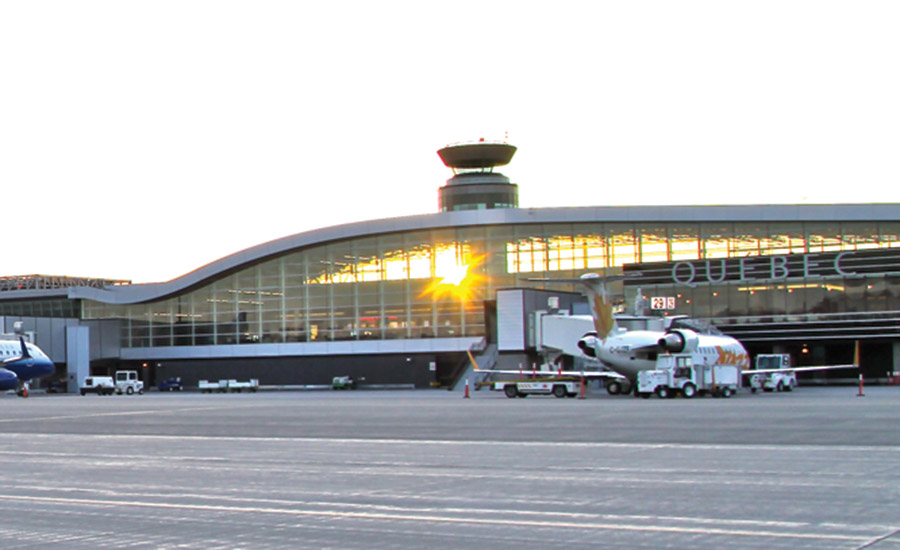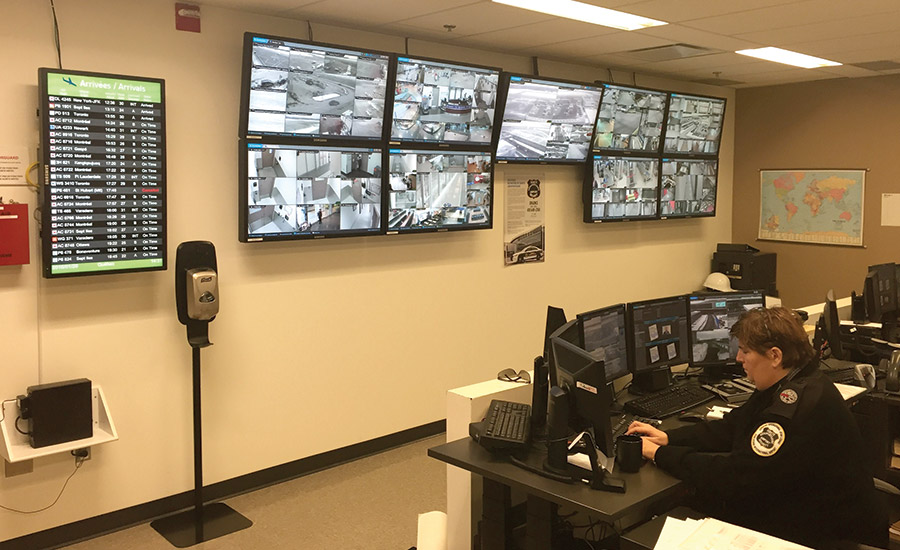The Québec City Jean-Lesage International Airport caters to 11 airlines and serves 1.6 million passengers per year. The latest expansion beginning in 2006 increased the terminal’s capacity and helped to enhance the level of customer service, but it also led to an enhanced security and operations system that is driving both airport efficiency and safety.
Located 160 miles north of Montreal, the Quebec City airport’s security and operations function hand-in-hand through the Security & Operational Control Center (SOCC), “the heart of our daily operations,” says Christian Labrosse, director of the airport’s SOCC. Within that overarching center, “the Security Operations Center (SOC) is our 9-1-1 station, where we manage calls, dispatch first responders and manage security incidents. In the Operations Center, we have both security and operational aspects, such as snow removal and gate management.”
The SOCC also includes fire alarms and specialized systems such as the Thor Guard weather alert system, which predicts lightning bolt strikes.
The video surveillance system is one of the major tools bringing value and efficiency to the airport, Labrosse says. The airport has approximately 240 cameras on the airport property, including fixed and pan-tilt-zoom cameras from AXIS Communications and Panasonic. In terms of gate assignments for incoming airplanes, if a flight at gate 30 is delayed in its boarding procedures, a warning would be sent through the system to alert an agent in the SOCC, who would then reassign the next incoming flight to a different gate. Similarly, a surveillance camera might detect that a vehicle is parked too close to an aircraft on the tarmac, and a SOCC agent could call in to have the vehicle moved or investigated.
By observing and detecting unusual behavior early, Labrosse adds, the airport can prevent security issues.
A security management system from Montreal-based company Genetec merges access control (Synergis) and video surveillance (Omnicast) in one platform: Security Center. “This integrated platform makes it faster for our security agents to process and manage incidents,” says David Robin, Manager of Security and Safety at the Quebec City Airport.
“The system doesn’t save us agents,” says Labrosse, “but it helps us be more efficient with the resources we have on the ground.”
For example, a surveillance camera is used to monitor each step of the automated baggage handling process, and can alert if there is a problem or delay. If a large crowd is gathering at the security checkpoint, the system would alert a SOCC agent, and he or she could give directions to a monitoring officer to go assist at the checkpoint. A common bottleneck area is the terminal curb, and when an abundance of slow or parked traffic is detected, parking agents could be informed and deployed to help move people along.
There is always an operational supervisor on duty, and he or she works closely with the security manager on duty. “Over their 12-hour shifts, the supervisor’s right arm is the security team manager,” says Labrosse. “They meet every morning to discuss that day’s tasks or challenges, and they work together in the same operations center. It’s a necessity.”
“If there’s a security breach in the terminal, or we have to evacuate, there is a direct impact on operations – a domino effect that can impact the whole airport,” says Robin.
Having operations and security working in such close quarters also helps the airport conform more closely with federal regulations. Canadian Air Transport Security Authority (CATSA) requires that access to restricted areas be supervised at all times, and biometric-based access is required through the Restricted Area Identity Card (RAIC) access program. The 184 employees of the airport’s managing company (Québec Airport Inc.) and the other 1,500 total employees at the airport have been entered into this system, and they must use their RAIC cards at HID access control readers and iris or fingerprint biometric readers throughout the airport to access employee-only or restricted areas.
The security management platform also simplifies the evidence-sharing practices for the airport. In the event of needing to share video footage with law enforcement partners, a SOCC agent can encrypt the footage onto a disk, or, if generic footage is needed to show in court, an unencrypted version can be transferred as well.
While all of these benefits were brought into the airport during the 2006-08 expansion, there is still plenty of room to learn and grow. The airport is currently in the midst of a major growth and expansion, set to open in 2018. The terminal will nearly double in size, and the surveillance camera count will similarly grow. However, the airport’s security leadership is more experienced this time around, and plan to put some of their knowledge to good use.
“Technology has changed since the last construction project finished in 2008,” says Robin. “We’re looking at HD surveillance cameras now, and that changes how we will use them. We’re testing how we can use HD fixed cameras to cover more ground, and then zoom in digitally afterward” instead of using PTZ cameras. After the expansion, the video surveillance system will be all IP, instead of the hybrid analog and IP system in the airport today.
“Christian and I have been involved since the beginning (of the expansion process),” adds Robin. “We conducted a needs analysis: put all of our requests and challenges down on paper. We have the terminal plans now, and we’re looking on where we can place our cameras and adjust our plans.”
“We’re working closely with the engineers who are constructing the site,” says Labrosse. “There is a lot of lateral communication,” so needs are communicated and addressed appropriately.
“We now have a chance to build security directly into the framework of the airport’s operations,” Labrosse continues. “This allows us to be more flexible, and to make sure that all needs are met.”
The expansion is not just building out the terminals, but reconstructing the SOCC as well, so Robin and Lebrosse have the opportunity to take their best practices and implement and improve them in a new space.
“We already know the processes that work, and now we can make sure that all cameras and access control readers are precisely installed to meet our needs and requirements,” says Robin. Having used the existing system for years, “we can be more specific about what we want. What we have now is good. It could be better.”



















